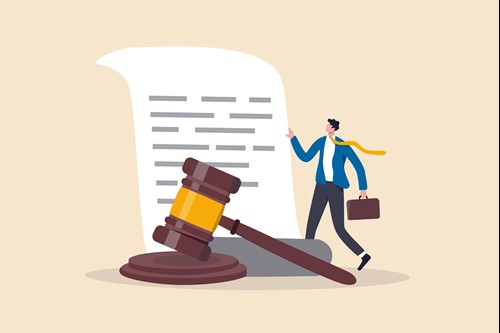For employers, going to employment tribunals can be scary, time-consuming and stressful. And that’s IF you win. A loss can mean reputational damage, expensive compensation and a drain of talented staff. Don’t worry, help is at hand!
When an employment issue gets to this point, you need to follow the right steps. That way, you can reach a resolution that's ultimately good for your business.
In this guide, we'll look at
- what an employment tribunal is.
- the different types of claims.
- How to deal with them.
- What the employment tribunal procedure is.
If you need immediate tribunal support or want to avoid employment tribunals, get in touch with one of our employment law experts on 0800 141 3813.

What is an employment tribunal?
Created in 1964, an employment tribunal (ET) is a judicial body who are specifically responsible for workplace justice and are on the largest tribunals in the greater tribunals system.
As an employer, if you find yourself facing an ET it will be a result of a claim brought against your business by a current or former employee. The tribunal is normally the last resort, following any attempts at conciliation using ACAS code-based advice. Claims can be raised by an employee against any of the following:
- Their employer.
- Their potential employer.
- A trade union.
For example, an applicant may raise a claim due to discrimination during the interview. Employment tribunals consist of a hearing to decide if a respondent has done something unlawful to the affected claimant.
These hearings are often seen as less formal than the Civil or High Court. But that’s not always the case. It all depends on what type of claim is raised to them. Their decisions and processes are governed by the law; therefore, are legally binding.
Examples of claims
There are many claims that employees can raise. Employment tribunals are commonly known as a platform for unfair dismissal and redundancy claims, but they can cover multiple things,such as:
- Dismissal: This includes wrongful dismissal, constructive dismissal, and unfair dismissal.
- Discrimination: This covers all nine protected characteristics. (For example, age; disability; gender reassignment; marriage or civil partnership; pregnancy and maternity; race; religion or belief; sex; and sexual orientation).
- Wages: This covers equal pay issues, reducing wages unlawfully and missing pay.
The vast majority of the ET caseload is compensation claims or other solutions made by workers against their employers. As an employer, if you have concerns about your current policies, procedures, contracts or documentation it may be worth considering outsourced HR support if you don’t have an in-house human resources department to avoid this eventuality.
What is the law on employment tribunals?
The main legal requirements for ETs are found in the Employment Tribunals Rules of Procedure 2013. The most important items of legislation are the Employment Tribunals Act 1996, the Employment Rights Act 1996 and the Equality Act 2010
Employees have a legal right to raise an employment tribunal claim. This right also extends to workers and job applicants. But this could vary depending on the type of claim).
They're also legally protected from discrimination and victimisation during this time. Meaning, you cannot treat someone less favourably for making a claim. If they're disciplined or face unfair dismissal, you could face serious consequences.
Both you and your employees must follow the proper steps throughout an employment tribunal. At tribunal stage if a party doesn't do what they should do with regards to tribunal proceedings the other side could make an application to get the claim struck out, it wouldn't be a win though and it wouldn't be automatic, it would be up to the tribunal ultimately as to whether a claim is struck out.

Do you have to pay to raise a claim?
This decision allowed employees to feel more confident in raising claims related to workplace issues. They also don't need to pay fees for raising claims to the Employment Appeal Tribunal.
Some of the most common consequences found are:
- Paying for any legal representatives (like a solicitor).
- Paying compensation (i.e., lost wages or damages. (From April 2022, the maximum award granted for unfair dismissal is £93,878).
- Giving a dismissed employee their job back. As an employer it is worth noting that this has led to a huge increase in the number of claims being brought by employees. It is imperative, therefore, that you guard against complacency and ensure that you protect your business from litigation.
How to deal with an employment tribunal claims process
You should try and resolve work-related disputes internally. That way you can avoid employment tribunals as much as possible. For employers, it's important to know how to deal with disputes – from start to end. Let’s take a look at these steps:
Check the claim requirements
Employees need to meet specific requirements to raise a claim in the first place.
For example:
- Most claims (not all) should be made within strict time limits (three months after the incident).
- Most claims (not all) should go through early conciliation first.
- Employees must contact ACAS about their dispute as soon as possible.
If a claim is raised after three months, it could be considered invalid. Unfair dismissal claims can only be brought against an employer once the employee has been continuously employed for 2 years.
Fill in a claim form
If both parties have gone through an unsuccessful early conciliation process, the employee may decide to start their employment tribunal claim.
They’ll need to fill in a FORM ET1. This copy should be sent to the respondent, their representatives, and ACAS. Employers must reply to the form within days. If you're late, it could lead to an automatic win for claimants.
Attend tribunal hearings
Once the form has been reviewed, the employment tribunal will hold a hearing. They could hold a preliminary hearing to go over certain factors, like evidence. Usually, no final decisions are passed during a preliminary hearing. But this isn’t always the case; i.e., the tribunal may decide to reject a claim.
If the preliminary hearing isn't needed, the employer will receive a date for the actual hearing.
This hearing is usually held by a panel - one judge and two lay members. Both parties will be asked questions about the dispute. They'll also cover all work documents, relevant evidence, and witness statements.
Wait for the final decision
Once the hearing is done, the tribunal may decide on the outcome. The judge may choose to hold another hearing to revisit certain issues. But in most cases, they'll pass a final decision straight away.
They might decide the employer is not at fault and dismiss the claim. But if the claim is upheld, the tribunal could award any of the following:
- Reinstatement: Giving the employee their job back.
- Re-engagement: Giving the employee a new position within the same business.
- Compensation: Giving the employee a cash or non-cash award.
Employees are allowed to appeal the final decision, but only in certain circumstances. They will advise the employee on how to raise this to the Employment Appeal Tribunal.

What's the employment tribunal procedure?
When an employee submits a claim, they need to follow certain steps, just as the employer does when responding. To keep it simple, we will give you a straightforward employment tribunal process guide below:
Step 1: Early Conciliation
This stage has to go through ACAS to get an early conciliation certificate that is quoted on the et1 (or specific in the employment tribunal process. To avoid wasting time and money, the staff member and the employer can attempt to find a solution now. ACAS helps the employee with advice, while our legal advisors can help you in the same way.
Step 2: Submitting a claim
The claimant needs to fill in and send the relevant form.
Step 3: Responding to the claim
The respondent needs to respond to the claim made.
Step 4: Assessing the merits
The judge will review both submissions and will decide what should happen next.
Step 5: Preparing for hearings
The judge decides on the employment tribunal process timescale and can request for further information. They will seek proposed remedies from the employer, who can present their assessment of the value of the claim. Documentation and witness statements will be presented to all parts involved.
Step 6: Hearings including remedy hearing
At this stage, the judge will listen to evidence from the witness and come to a decision. The remedy hearing will set out any award payable to the employee.
Step 7: Appeal
Any of the parties involved can decide to make an appeal.
What is the employment tribunal hearing procedure?
We will next walk you through what is happening during a hearing, so you know what to expect.
If the hearing takes place in person, the clerk greets the employee and employer separately. They guide them to separate waiting rooms. Both the claimant and the respondent will give evidence of oath, with or without a holy book involved.
Online, all you need to remember is to have the link the tribunal sent you ready. Also, keep your phone available, but silent, in case they need to contact you that way.
As an employer, you can submit new evidence during the hearing. The judge will weigh and decide on its relevance. If they find it relevant, you will be allowed to use it. Remember though, if the claimant makes a valid point about not having had enough time to prepare, you risk incurring further costs. The judge might ask you to pay them for the time they need to prepare their response.
You can offer to settle the dispute on the day, and we recommend you do it through your representative. They will discuss with the representative of your employee, or the individual themselves. This takes the pressure and stress off your hands, reducing the risk of getting distracted and making mistakes.
You will give evidence, as will the claimant and any witnesses. Makes sure that you don’t leave anything out and that you address all the points in the claim.
Your representative will also cross-examine the claimant.
Employment Tribunal rules in the UK
At each of the stages explained above, rules of procedures apply. The UK Government provides extensive documentation on how the whole process should take place. While this can feel like a lot of information to grasp and navigate, let’s break it down to the main points.
The rules detailed in government documentation offer the legal framework for:
- Starting a claim
- Responding to a claim
- Contract claims
- Case management orders
- Hearings
- The judge’s decision
- Costs orders
- Delivering documents
Bear in mind these rules outline how each stage should look once the employee made the claim. The advice given to workers encourages them to go the early conciliation route first. This gives the employer a chance to settle the conflict before it escalates into a court case.
Besides the early conciliation that could prevent an employment tribunal, your grievance procedure could help you solve work disputes early. The rules we mentioned also set out minimum requirements for each stage to proceed.
Requirements in the employment tribunal procedures
The employment law tribunal procedure starts with the employee making the claim. While this interests you less as an employer, it helps to know what needs to happen for this to progress into the next stage.
They need to submit an ET1 claim form, within the three-month time limit from the incident. Claimants can do so online and provide the minimum relevant information for the judge to consider the case. As explained in governmental documents, this form needs to supply each claimant’s name and address, and each respondent’s name and address.
Why multiple claimants and respondents?
Let’s consider a real-life example. Several young employees, under the age of 25, decide to submit an age discrimination claim, after early conciliation failed. In this case, you’ll have multiple claimants.
In another example, one or more workers decide to make a claim against both their line manager and senior management. In this case, they will provide all the respondent's names and addresses. Otherwise, the judge will likely decide to reject the claim.
After rejecting the case, the judge could reconsider if the claimant can rectify the mistake.
In the next stage, they will forward a copy of the claim form to the respondent/s. They will also communicate how to submit a response and how much time they have to do so. Information about what will happen if the employer fails to respond will also be included. You need to be aware of and follow all the minimum requirements to avoid losing in court.

What about the employment tribunal appeal procedure in the UK
If you find the judge’s decision unsatisfactory, you might ask yourself what next?
As an employer, you can follow the employment tribunal appeal process. Consider the reasons carefully, and only decide to go this route if you think:
- The ET interpreted the law wrongly.
- The ET applied the law wrongly.
- The ET lacked evidence that justifies their decision.
- The ET was biased against you.
You can also choose the employment appeal tribunal process if you have evidence that the procedures were not followed correctly. Make sure you support your appeal with clear, strong arguments, otherwise, you risk wasting more time and money on an already lost cause.
How to minimise employment tribunal claims
Employers should do their best to stop employment disputes from happening in the first place. If an employee has raised a complaint, you should deal with it in a fair and lawful manner. This also helps to keep minimise any impacts on your work morale and relations.
You can use minimise the risk of claims reaching employment tribunals through:
Disciplinary and grievance procedures
The first step to consider is your disciplinary and grievance procedure. Most workers will be familiar with this practice. It's usually added to their employment contract or handbooks.
Some issues can be resolved through an informal talk or meeting. Other times, it'll need to go through a more formal hearing.
Early Conciliation
When an employee wants to raise a claim, they must use early conciliation first. This is one of five forms of alternative dispute resolution (ADRs). A neutral person (or conciliator) will look at the circumstances presented to them. After talks, they'll suggest a decision that helps both parties.
But conciliators can only give advice during meetings. They can't enforce final decisions - only suggest them. Early conciliation is free of charge and often informal. But final decisions aren’t always legally binding (unless they go through a COT3 process).
Settlement agreement
Another step employers can take is using settlement agreements. a settlement can be offered at any time but the employee might be more willing to agree if other processes have already been followed. If there is an existing dispute discussions about cannot be brought before the tribunal (the without prejudice rule), nor can they be raised in cases of unfair dismissal (when a protected conversation has taken place)
Both parties will usually decide to settle outside of a tribunal hearing. After discussions, they’ll aim to reach a mutual decision like a financial payment or employment benefit. If the claimant decides to settle, they'll need to retract their tribunal claim.

Get expert advice on employment tribunals with Croner
Making a claim to tribunals happens more often than you'd think. That’s why employers need to do their best to resolve issues internally.
Make sure you follow all the rules for tribunal hearings. If you ignore any steps, you could face losing workers, expensive fines, and brand damage. But you don’t need to deal with this alone. From dealing with the initial claim form to the final hearing, our HR advisors are here to help.
Need more advice on employment tribunals? Speak to a Croner expert in regard to any HR or employment law issue on 0800 141 3813
Related resources
Categories
- Business Advice
- Culture & Performance
- Disciplinary & Grievances
- Dismissals & Conduct
- Employee Conduct
- Employment Contracts and Documentation
- Employment Law
- Employment Rights Bill
- End of Contract
- Equality & Discrimination
- Health & Safety
- Hiring and Managing
- Leave & Absence
- Managing Health & Safety
- Moving
- Occupational Health
- Pay & Benefits
- Recruitment
- Risk & Welfare





